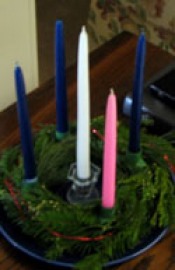What is Advent?

The word "Advent" comes from the Latin word advenire, which means "coming" or "arrival." It refers to the idea that God comes to the world through the birth of Jesus. Advent is the first of the seasons of the liturgical year year because it begins the story of Jesus' life, death, and resurrection. The season of Advent recalls both the anticipation of the coming of the Messiah by the people of Israel, and the waiting for the second coming of Christ. Unlike secular preparations for Christmas, Advent is a time to study and pray; it is a time of calm and thoughtfulness.
Advent begins four Sundays before Christmas (the First Sunday of Advent) and ends at sundown on Christmas Eve.
The colors of Advent are purple or blue. Purple symbolizes the royal nature of the Messiah's coming and penitence (our acknowledgement of and regret for our sins) and in this sense, it is used in the season of preparation for Christmas. Blue symbolizes the hope the Messiah brings to the world.
In earlier days marriages were not solemnized in the church during this season and the faithful were asked to abstain from public amusements. From the 4th century the season was kept as a period of fasting as strict as that of Lent. The fasting rule was later relaxed, while keeping Advent as a season of penitence.
Advent is normally celebrated only by denominations that follow the liturgical seasons: Episcopalians, Roman Catholics, Lutherans, Methodists, and Orthodox Churches.